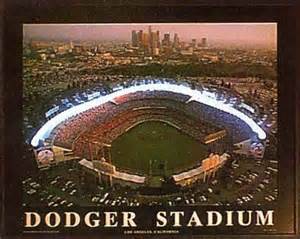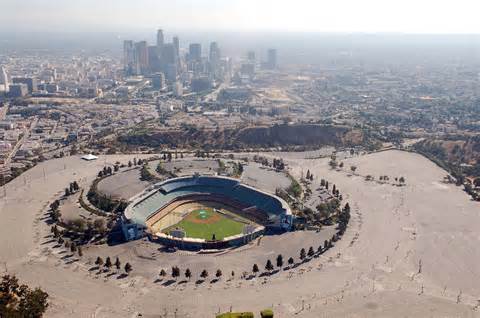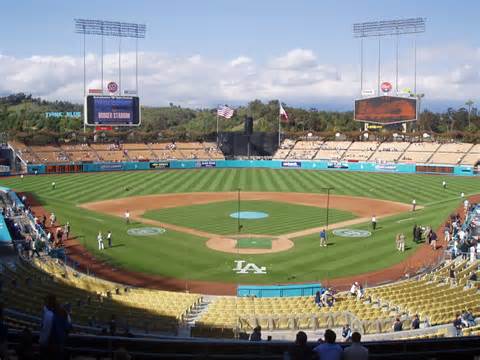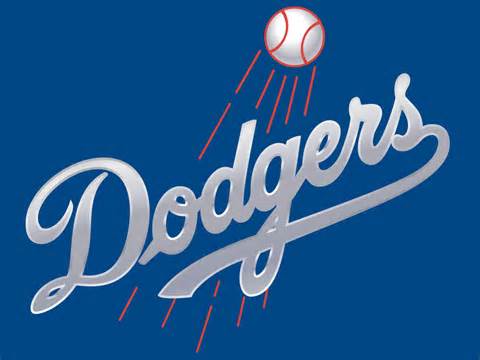Dodger Stadium
Dodger Stadium been the home of the Los Angeles Dodgers, of the National
League Western Division, since 1962. The stadium is currently the third oldest
in major league ball park, behind only Wrigley Field and Fenway Park.
Dodger History:
During the early and mid -1950s, Brooklyn Dodger owner, Walter O’Malley
attempted to build a Domed Stadium in the New York borough of Brooklyn, but was
unable to reach an agreement with city leaders on acquisition of the required
property.

Meanwhile, in the early 1950’s land, known as Chavez Ravine, was being bought
or taken by right of eminent domain, by the City of Los Angeles with funds
acquired by the Housing Act of 1949. The intended use of the land was to build
Elysian Park Housing Project, which included 2 Dozen 13 story buildings and 160
two-story town houses. This project lost favor in Los Angeles and the ground
was purchased, at an extreme discount, from the Federal Housing Authority, with
the pledge the ground would be designated for public use.
In 1958 the Dodgers
bought the property from the city, began plans to build a baseball stadium, and
moved the Dodgers from Brooklyn to Los Angeles, where the team played 3 years
in the Los Angeles Memorial Coliseum, which had a 90,000 seat capacity.

Dodger Stadium Features:
The stadium offers numerous unique features, many which have been
incorporated into stadiums built afterwards. O’Malley was impressed with the
dugout level seats behind home plate he saw in Tokyo’s Korakuen stadium during
the team’s goodwill tour of Japan in 1956 and incorporated
the seats in Dodger Park.
Dodger stadium’s wavy roofs over each outfield pavilion and the top of a 10
story elevator shaft, located behind home plate, of the upper seating level,
with its Dodger Logo, are two unique features.
The stadium parking lots, which are quite ample, are terraced in order to place
season ticket holders parking at the same level as their seats eliminating the
use of ramps once inside the park.
Much forethought was taken to build the stadium as Earth Quake proof as
possible, a desirable option for California, and it has withstood several large
earth quakes with only minor damages.
Remembering Dodger Heroes:
In order to remember both Brooklyn and Los Angeles’ baseball greats, the
retired numbers are displayed under the pavilion roof tops. These retired
numbers include Pee Wee Reese, Jackie Robinson, Duke Snider, Tommy Lasorda,
Walter Alston, Roy Campanella, and Jim Gilliam.

Location and No Drainage:
Dodger Stadium is located in the Los Angeles community of Chavez Ravine in Sulfur Canyon. The park overlooks downtown Los Angeles on the South, Elysian Park, with its green tree lined hills to the North and East, and the San Gabriel Mountains from beyond the outfield pavilions.
Due to this location and the historical dry summer months in Southern
California, rainouts are very rare, eliminating the requirement for extensive
underground drainage systems. Prior to 1976 the Dodgers
experienced only 1 rainout, against the St. Louis Cardinals on April 21, 1967.
Dodger stadium is the Only, with the exceptions of new ball parks, which has
never changed the seating capacity of the park. California has a
Conditional-Use Permit pertaining to the stadium’s capacity which limits it to
56,000. Any time seats are added to the facility, the same number of seats are
subtracted from another area in the stadium.

Pitcher Friendly Or Not?
For the most part Dodger
stadium is considered a pitcher friendly ball park with power alleys being 380
feet, a pretty good drive. In order to make the park more even for hitters,
they moved home plate 10 feet closer to center field, bringing all the dimensions
in. However, this 10 foot move also increased Foul Territory by 10 feet, which
resulted in many formerly out of play foul balls, now being caught.
Another factor which voids a pitchers’ advantage are late afternoon games. As
the sun sets the moist ocean air rushes in and cools the air, making it denser
and adds moisture to the normally dry air, which reduces the distances balls
travel.
Dodger Stadium Specifics:
Location: 1000 Elysian Park Ave. DodgerTown, Cal. 90090
Date Stadium Broke Ground: September 17, 1959
Date Stadium Opened: April 10, 1962
Playing Surface: Santa Anna Bermuda Grass
Construction Cost: $23 million
Field Dimensions:
Left Field - 330 feet
Medium Left Center Field - 360 feet
True Left Field - 375 feet
Center Field - 400 feet
True Right Center
Field - 375 feet
Medium Right Center Field - 360 feet
Right Field - 330 feet
Back Stop - 55 feet
Dodger Stadium to Baseball Stadiums

New! Comments
Have your say about what you just read! Leave me a comment in the box below.